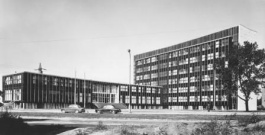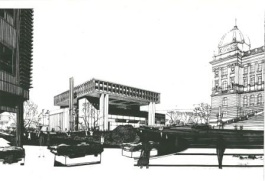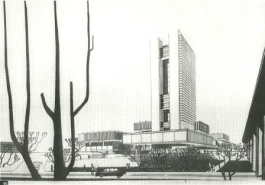
To the uncelebrated 90th birthday of Karel Prager
Radomíra Sedláková
 |
| Institute of Macromolecular Chemistry in Prague |
 |
| K. Prager, J. Albrecht, J. Kadeřábek: Competition design for the National Assembly building |
 |
| K. Prager, J. Albrecht, J. Kadeřábek: Competition for the design of the Hlávka Bridge approach |
Among Karel Prager's important activities was a great interest in building technology, new building materials, and new structures. He himself held several significant patents, which he consistently used in his buildings - for example, the entire Gama system, of which the partition cabinets are the most famous and probably the most commonly used by others. Additionally, he was an initiator of the establishment of the former Czechoslovak Center for Construction and Architecture. In the 1990s, he was a founding member of the Pangea Foundation, the founder of the Block of Architects and Artists, and his membership in the New Group was equally important. His membership was never just a formal matter but always an important active driver of events.
To commemorate his posthumous birthday, the National Gallery in Prague, in collaboration with Atelier Gama and Casua company, is preparing a major retrospective exhibition, and the Titanic Publishing House will release a representative book during the autumn.
The English translation is powered by AI tool. Switch to Czech to view the original text source.
0 comments
add comment











